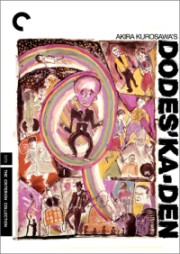 Criterion has decided to give out its Christmas gifts early this year, with the company announcing the release of Dodesukaden on March 17th next year.
Criterion has decided to give out its Christmas gifts early this year, with the company announcing the release of Dodesukaden on March 17th next year.
After a few less than desirable (and more than unavailable) Chinese releases, this marks the first time Dodesukaden (spelled Dodes’ka-den by Criterion) is available on DVD with English subtitles.
Criterion’s release promises a new, restored high-definition digital transfer, as well as the now-standard episode of Toho’s Akira Kurosawa: It Is Wonderful to Create series, here concentrating on the creation of Dodesukaden. Also included are a trailer and a booklet that includes a new essay by Stephen Prince, plus an interview with Teruyo Nogami.
What the release sadly seems to lack, however, is a commentary track. You can find the above information on Criterion’s website.
Thanks to Christopher for bringing this new release to our attention!
In related news, Criterion is also making Ikiru available as part of their second Essential Art House box set, released on 10th of February 2009. The first box set, released earlier this year, included a copy of Rashomon.







Since it’s a onomatopoeia(I actually spell that without the aid of Google) is it wrong to use any hyphens or apostrophe(needed Google for that one)?
How should it spelled? Assuming there is a right and wrong way.
Just curious.